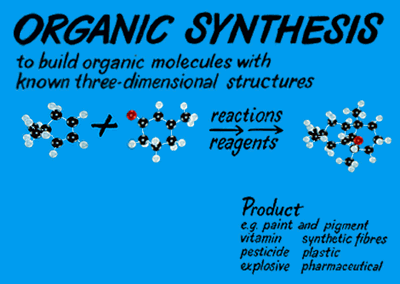Organic synthesis – science and art
The history of organic synthesis starts with the German chemist Friedrich Wöhler who, in 1828, succeeded to make urea from simple materials. This was the first time when organic (=living) matter was produced from inorganic (=dead) matter. This was not believed to be possible, at the time.
By the end of the nineteenth century valuable colours, such as indigo and many aniline-colours, became available through synthesis from cheap starting materials by, among others, Adolf von Baeyer, Germany (1905*). At the turn of the century Emil Fischer (1902*) in Berlin had started his elegant elucidation of the structure and stereochemistry of sugars. At the same time new methods to make carbon-carbon bonds were developed by, among others, the Frenchman Victor Grignard (1912*).
At the end of the 1920’s the art of synthesis had made major advances. Hemin, the oxygen-binding part of the red bloodplates, was synthesised by the German, Hans Fischer (1930*). Vitamin B6 was synthesised in 1939 and vitamin A in 1949. The Germans, Otto Diels and Kurt Alder (1950*) discovered one of the most simple and elegant methods that exists for the synthesis of rings with six carbon atoms.
During the 1950’s the development was rapid and many challenging molecules such as strychnine and morphine were made synthetically. Cortisone was prepared synthetically in 1951 by the Englishman Sir Robert Robinson (1947*) and the American Robert B. Woodward (1965*), penicillin in 1957 by John C. Sheehan and chlorophyll by R.B. Woodward in 1960.
The art of organic synthesis continues to develop. In 1979 Herbert C. Brown, USA and Georg Wittig, Germany, shared the Nobel Prize in chemistry for their development of boron and phosphorous compounds, respectively, into useful reagents in organic synthesis.
The discovery of the prostaglandins was made by Sune Bergström and Bengt Samuelsson in Sweden and by Sir John R. Vane in England (1982*). The prostaglandins occur in very small amounts in the body and take part in important life processes. With great skill, E.J. Corey has determined the structure of many prostaglandins and synthesized them. Through his contributions many of these are now available to medicine.
A number of other chemicals with complicated structures has been synthesized during the last three decades and this year’s Nobel Laureate, Elias J. Corey, has played a key role also in these developments. Some examples of biologically-active compounds synthesized in Corey’s laboratory are shown in this poster.
* Nobel Prize


Nobel Prizes and laureates
Six prizes were awarded for achievements that have conferred the greatest benefit to humankind. The 14 laureates' work and discoveries range from quantum tunnelling to promoting democratic rights.
See them all presented here.
